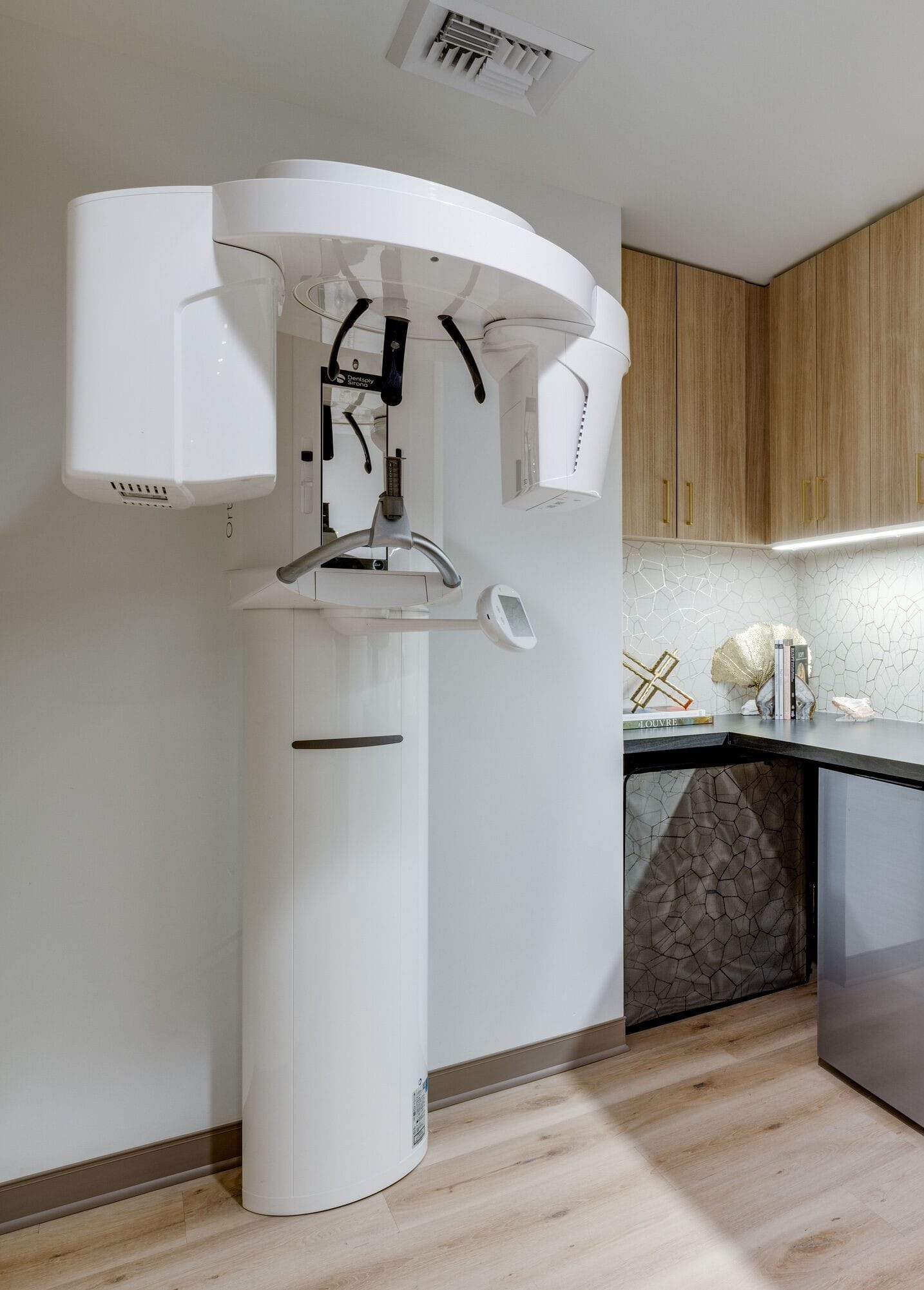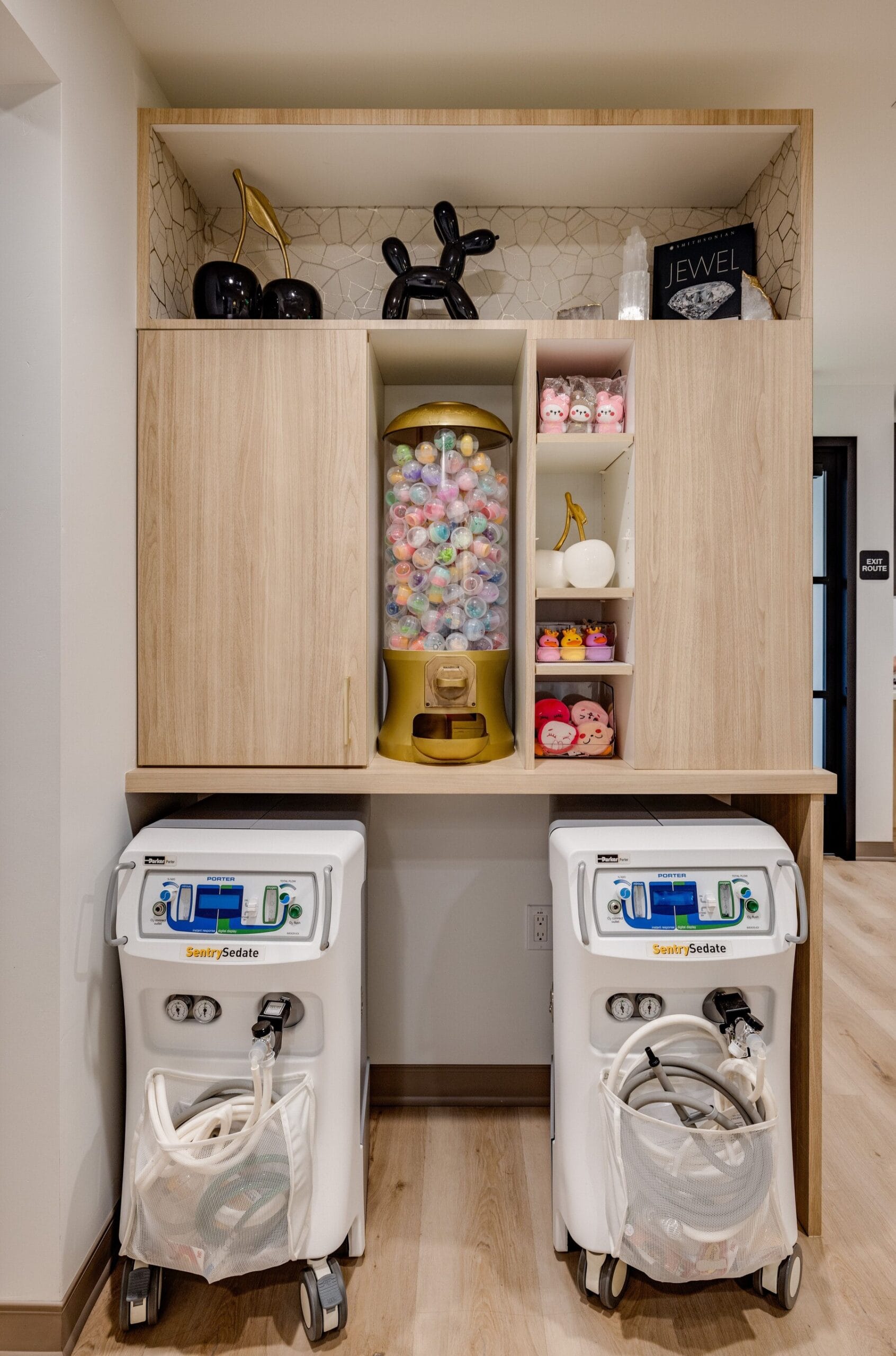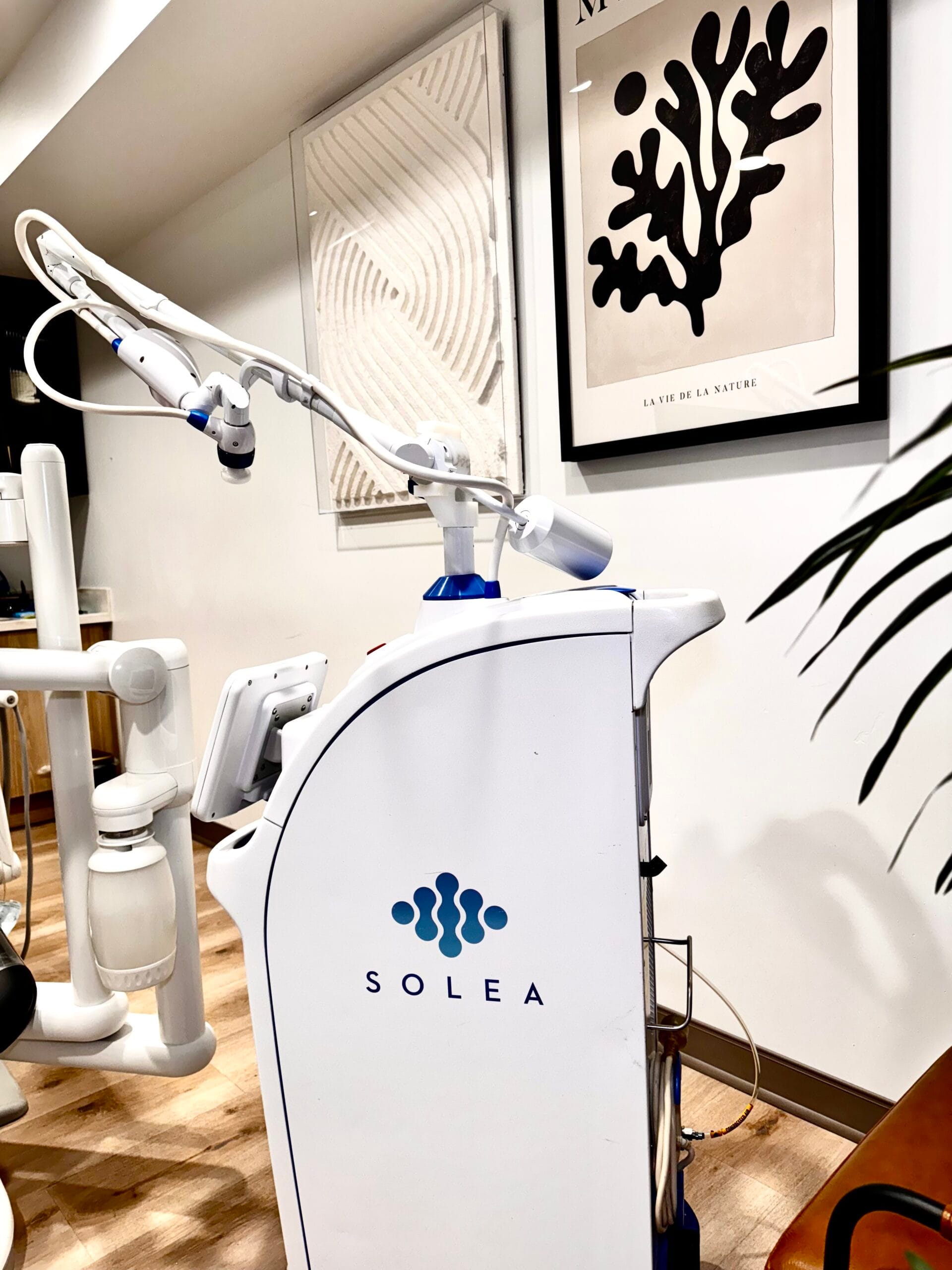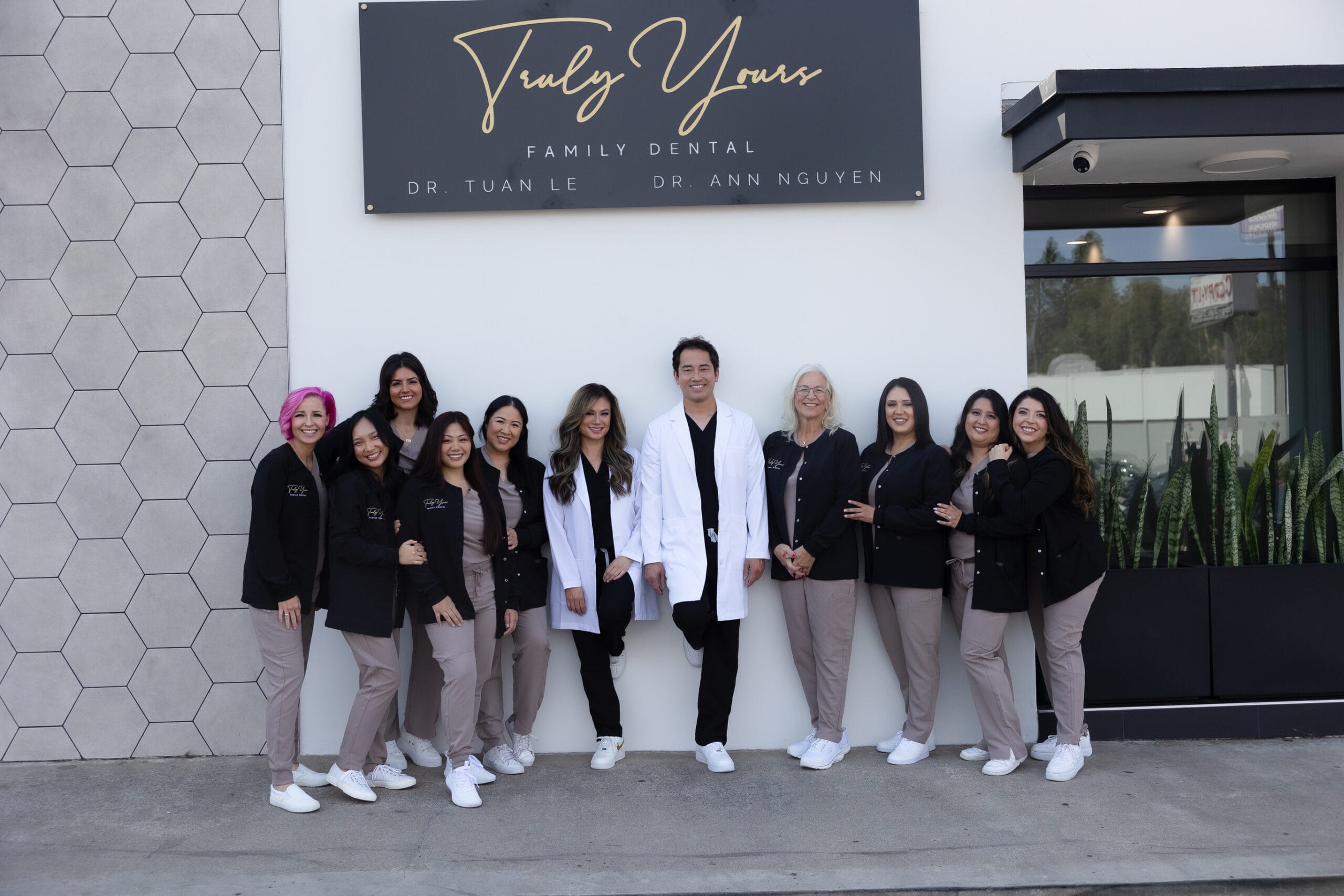Welcome to Truly Yours Family Dental!
At Truly Yours Family Dental, we are dedicated to providing you and your family with the highest quality dental care in La Mesa, CA. Our dentist office combines state-of-the-art dental technologies with traditional values like excellent customer service and personalized care. From the moment you walk in, you’ll notice our welcoming and relaxing atmosphere designed to put you at ease. We offer modern cosmetic and restorative dentistry techniques, making it easier than ever for you to leave our office with a beautiful smile. Our team at Truly Yours Family Dental prides itself on a gentle touch, sensitivity, and genuine compassion.
Read More
Our mission is to be your trusted dentist, ensuring your complete oral health and overall well-being. At Truly Yours Family Dental, we understand the significant impact that dental health can have on your quality of life. Dr. Le and Dr. Nguyen are committed to addressing dental anxiety for both children and adults, promoting strong oral hygiene, and offering high-end services with a focus on family care. We genuinely care about our patients, considering their complete health, and aim to provide all necessary treatments in one convenient location. Our goal is to provide precise and effective treatments, such as surgically guided implants, ensuring you receive the best possible care from your dentist.
Meet the Doctors!
Dr. Tuan Le and Dr. Ann Nguyen are a dynamic husband-and-wife team of dental professionals, both proud California natives. Their journey together began at the University of California, San Diego (UCSD), where they met and earned their Bachelor of Science degrees. Pursuing their passion for dentistry, they both attained their Doctor of Dental Surgery degrees from Creighton University in Omaha, Nebraska, one of the nation’s top dental schools.
After gaining extensive clinical experience in Phoenix, Arizona, they returned to San Diego to offer exceptional dental services to their community. Their state-of-the-art dental practice reflects their commitment to high-quality care, combining advanced technology with a warm, family-friendly environment.

Dr. Le
Dr. Le’s meticulous and friendly nature makes him a favorite among patients. He is an avid sports fan, especially fond of basketball, and enjoys socializing and making his patients feel at home. Dr. Le’s perfectionism ensures that each patient receives thorough and precise care, as he continually updates his knowledge with the latest dental advancements. His dedication to treating patients like family means that everyone receives the best possible dental care. Dr. Le’s passion for dentistry is evident in his commitment to keeping patients’ mouths healthy and disease-free, creating an engaging and comfortable experience for all.

Dr. Nguyen
Dr. Nguyen is known for her nurturing and gentle approach, especially with children. Her vast experience in pediatric dentistry and her use of the “tell, show, do” technique helps children feel comfortable and at ease during their visits. A foodie who enjoys exploring new restaurants, she likes interior design, decor, and DIY projects, often bringing this same creativity and patience into her dental practice. She is deeply sensitive to dental anxiety and strives to ensure that every patient, regardless of age, has a positive experience. Dr. Nguyen’s warm and compassionate nature naturally attracts children, making her an invaluable asset to the practice. Her primary mission is to provide a pleasant and anxiety-free dental experience for all, starting from a young age.
Our Services
- Surgically Guided Implants
- CEREC
- Crown and Bridge
- Pediatrics
- Laser Dentistry
- Extractions
- Fillings
- Emergency Care

Understanding Surgically Guided Implants
Surgically guided implants are a revolutionary advancement in dental technology that allows dentists to place dental implants with unparalleled precision. These implants use advanced imaging techniques and computer-aided design to create a detailed map of your mouth, ensuring that the implants are placed in the optimal position for both function and aesthetics. By using this technology, a dentist can avoid critical anatomical structures and provide a more predictable outcome compared to traditional methods.
The primary function of surgically guided implants is to replace missing teeth with prosthetic teeth that look, feel, and function like natural teeth. This technology helps in creating a customized treatment plan that is tailored to your unique dental structure. The benefits of surgically guided implants include increased accuracy in implant placement, reduced surgery time, and faster recovery. Unlike traditional implants, surgically guided implants provide a higher success rate and minimize the risk of complications.
How Surgically Guided Implants Work
Surgically guided implants work by utilizing detailed 3D imaging of your jawbone. This imaging allows the dentist to plan the exact position, angle, and depth of each implant before the actual surgery. The process starts with a digital scan of your mouth, which is then used to create a virtual model. The dentist uses this model to design a surgical guide, which is a template that directs the precise placement of the implants during surgery.
The use of this technology ensures that the implants are placed in the most stable and healthy parts of the jawbone, enhancing their longevity and functionality. This method also allows for less invasive procedures, which means less discomfort and quicker healing for patients. By reducing the guesswork involved in traditional implant placement, surgically guided implants offer a more efficient and effective solution for tooth replacement.
Benefits of Surgically Guided Implants
- Increased Precision: The exact placement of implants ensures a natural look and feel.
- Reduced Surgery Time: The pre-planned approach shortens the duration of the procedure.
- Faster Recovery: Less invasive techniques lead to quicker healing and less post-operative pain.
- Higher Success Rate: Improved accuracy reduces the risk of complications.
- Customized Treatment: Each implant is tailored to fit your unique dental structure.
Unique Advantages of Surgically Guided Implants
- Avoids Critical Structures: Ensures implants do not interfere with nerves or sinuses.
- Enhanced Aesthetics: Precise placement enhances the appearance of the prosthetic teeth.
- Improved Functionality: Better alignment with natural teeth for optimal chewing and speaking.
- Minimal Discomfort: Reduced trauma to the surrounding tissues leads to less pain.
- Predictable Outcomes: The detailed planning provides consistent and reliable results.
Impact on Daily Life
Surgically guided implants have a profound impact on your daily life. With their natural look and feel, they restore your ability to eat, speak, and smile with confidence. These implants are designed to integrate seamlessly with your existing teeth, providing a stable and secure foundation for your new teeth. The enhanced accuracy and precision of surgically guided implants mean fewer follow-up visits and adjustments, allowing you to enjoy a hassle-free dental experience.
Furthermore, surgically guided implants help preserve the integrity of your jawbone, preventing the bone loss that often accompanies missing teeth. This preservation of bone structure maintains the natural shape of your face, contributing to a more youthful appearance. With surgically guided implants, you can experience a significant improvement in your quality of life, enjoying the benefits of a healthy, functional, and aesthetically pleasing smile.
The Dentist and Surgically Guided Implants
Choosing surgically guided implants from a dentist ensures that you receive the highest standard of care and precision. This advanced technique allows the dentist to provide a tailored solution that meets your specific needs, resulting in a more comfortable and effective treatment process. By incorporating the latest technology, your dentist can deliver exceptional results that enhance both your oral health and overall well-being.
In summary, surgically guided implants offer a modern and efficient approach to tooth replacement, providing numerous benefits over traditional methods. With increased precision, reduced surgery time, and faster recovery, these implants are a superior choice for those seeking a reliable and long-lasting dental solution. Trusting your dentist to use surgically guided implants ensures you receive the best possible care, improving your dental health and quality of life.

Understanding CEREC
CEREC, or Chairside Economical Restoration of Esthetic Ceramics, is a cutting-edge dental technology that allows a dentist to design, create, and place high-quality ceramic dental restorations in a single visit. This system uses computer-aided design (CAD) and computer-aided manufacturing (CAM) to produce precise and durable crowns, veneers, inlays, and onlays. The process begins with the dentist taking a digital impression of the patient’s teeth, eliminating the need for messy traditional molds. The digital impression is then used to create a 3D model of the restoration, which is milled from a block of ceramic material right in the dental office.
CEREC is used to restore damaged or decayed teeth efficiently and effectively. The primary function of CEREC is to provide patients with a convenient and rapid solution for their dental restoration needs, without compromising on quality or durability. Unlike traditional methods that require multiple appointments and temporary restorations, CEREC allows the dentist to complete the entire process in a single visit. This not only saves time but also reduces the discomfort and inconvenience associated with multiple dental visits.
How CEREC is Used
The use of CEREC begins with the dentist preparing the affected tooth by removing any decay or damaged material. Next, a digital scan of the tooth is taken, which is more comfortable and accurate than traditional impressions. The digital image is then used to design the restoration on a computer screen, ensuring a precise fit and optimal aesthetics. Once the design is complete, the CEREC machine mills the restoration from a ceramic block in about 15-20 minutes. The dentist then fits, adjusts, and bonds the restoration to the tooth, completing the entire procedure in a single visit.
CEREC restorations are highly beneficial due to their precision, durability, and aesthetic appeal. The ceramic material used in CEREC restorations closely matches the natural color and translucency of teeth, providing a seamless and natural-looking result. Additionally, because the restorations are designed and created using advanced digital technology, they fit more accurately and are less likely to require adjustments over time. This makes CEREC an excellent choice for patients seeking efficient, high-quality dental care.
Key Features of CEREC
- Single-Visit Restorations: Complete the entire process in one appointment.
- Digital Impressions: No need for traditional molds.
- High Precision: CAD/CAM technology ensures a perfect fit.
- Durable Material: Made from strong, long-lasting ceramic.
- Natural Appearance: Matches the color and translucency of natural teeth.
Unique Advantages of CEREC
- Time-Saving: Reduces the number of visits required.
- Comfortable Experience: Digital scanning is quick and easy.
- Immediate Results: No need to wait for lab-created restorations.
- Customizable: Tailored to fit your specific dental needs.
- Minimally Invasive: Conserves more of the natural tooth structure.
The Dentist and CEREC
Choosing a dentist who offers CEREC technology ensures you receive the most advanced and convenient dental care available. The dentist will use their expertise to create precise, custom restorations that enhance both the function and appearance of your teeth. With CEREC, you can enjoy the benefits of a streamlined process, minimal discomfort, and long-lasting results.
In summary, CEREC is an innovative dental solution that combines advanced technology with the expertise of a dentist to provide high-quality, same-day restorations. This technology streamlines the dental restoration process, making it more efficient and comfortable for patients. By opting for CEREC restorations, you can save time, reduce the number of dental visits, and achieve a beautiful, natural-looking smile. Trusting your dentist to use CEREC technology ensures you receive exceptional care and lasting results.
Dentist and CEREC: The Future of Dental Restorations
A dentist utilizing CEREC technology can offer you the best in modern dental care, combining efficiency, precision, and aesthetics. With CEREC, you benefit from a quick, comfortable, and highly effective restoration process that fits your busy lifestyle. Trust in the advanced capabilities of CEREC and the expertise of your dentist to maintain your oral health and enhance your smile with cutting-edge dental restorations.

What is a Crown and Bridge?
Crown and bridges are two common types of dental restorations used to replace missing teeth and restore the function and appearance of your smile. A crown, also known as a cap, is a custom-made covering that fits over a damaged or decayed tooth to strengthen and protect it. A bridge, on the other hand, is used to fill the gap left by one or more missing teeth. It consists of one or more artificial teeth, anchored in place by crowns on the adjacent natural teeth or implants.
The primary function of a crown is to restore the shape, size, and strength of a tooth, while also improving its appearance. A bridge is designed to replace missing teeth, helping to maintain the alignment of your teeth and the integrity of your bite. Both crowns and bridges are typically made from durable materials like porcelain, ceramic, or metal, ensuring a natural look and long-lasting results.
How a Crown and Bridge is Used
Crowns are used when a tooth is too damaged to be repaired with a filling but still has enough structure to support a cap. They are commonly used after root canal treatments, to repair broken teeth, or to cover large fillings. Bridges are used to replace one or more missing teeth, preventing the remaining teeth from shifting out of position and helping to maintain proper chewing and speaking functions. The process involves preparing the adjacent teeth for crowns, creating a mold of your teeth, and fitting the custom-made bridge.
A dentist will start by taking impressions of your teeth to ensure a perfect fit for the crown or bridge. The affected tooth or teeth are then prepared, which may involve removing some of the outer layers to make space for the crown or bridge. Temporary crowns or bridges are placed while the permanent ones are being made. Once ready, the permanent crowns or bridges are fitted and cemented into place, restoring your smile and function.
Benefits of a Crown and Bridge
- Restores Functionality: Enables proper chewing and speaking.
- Improves Appearance: Provides a natural look that blends with your existing teeth.
- Prevents Shifting: Keeps remaining teeth in their proper position.
- Durable: Made from strong materials that last for many years.
- Enhances Oral Health: Protects against further damage and decay.
Unique Advantages of a Crown and Bridge
- Custom-Made: Tailored to fit your specific dental needs and aesthetics.
- Versatile: Suitable for a variety of dental issues, from single tooth restoration to multiple teeth replacement.
- Minimal Maintenance: Easy to care for with regular brushing and flossing.
- Supports Jawbone: Helps maintain the structure of your jaw by preventing bone loss.
- Quick Procedure: Can often be completed in just a few visits to the dentist.
Your Dentist and Crowns and Bridges
Choosing a dentist to perform your crown and bridge procedure ensures you receive expert care and personalized treatment. Your dentist will evaluate your oral health, discuss your options, and create a custom plan tailored to your needs. By focusing on both function and aesthetics, your dentist ensures that your new crown or bridge not only restores your smile but also feels comfortable and natural.
In summary, crown and bridge treatments are essential for restoring damaged or missing teeth, providing numerous benefits for your oral health and appearance. By understanding what crowns and bridges are, how they are used, and their unique advantages, you can make informed decisions about your dental care. Trusting your dentist with these procedures ensures you receive high-quality, customized treatment that enhances your smile and overall well-being.
Dentists and Crowns and Bridges: Your Path to a Healthier Smile
A dentist plays a crucial role in providing crown and bridge treatments, offering expertise and personalized care to restore your smile. These treatments not only improve the functionality and appearance of your teeth but also help maintain your oral health. By choosing a dentist who prioritizes your comfort and needs, you can achieve a healthier, more confident smile. Regular visits and proper care will ensure your crowns and bridges last for many years, making them a valuable investment in your dental health.

What is Pediatrics?
Pediatrics in dentistry is dedicated to the oral health of children from infancy through their teenage years. A pediatric dentist focuses on the unique dental needs of young patients, ensuring their teeth, gums, and mouth develop properly. The primary goal is to provide comprehensive dental care that includes preventive, diagnostic, and treatment services. By focusing on early detection and prevention, a pediatric dentist helps maintain children’s oral health and prevent future dental issues.
Pediatric dentistry includes a range of services designed to address the specific needs of children. This includes regular dental check-ups, cleanings, fluoride treatments, and dental sealants. A pediatric dentist also provides guidance on proper brushing and flossing techniques and offers advice on nutrition and oral habits like thumb sucking. These practices are essential for establishing good dental hygiene habits that can last a lifetime.
How Pediatrics is Used in Dentistry
Pediatric dentistry uses various techniques and tools tailored to make dental visits comfortable and stress-free for children. Regular check-ups and cleanings are crucial for maintaining oral health and identifying any potential issues early. During these visits, a pediatric dentist will examine your child’s teeth, gums, and jaw development. They may also apply fluoride treatments and dental sealants to protect against cavities. The use of child-friendly methods ensures that young patients feel at ease during their dental appointments.
In addition to preventive care, pediatric dentists are skilled in managing more complex dental issues that may arise. This includes treating cavities, addressing bite and alignment problems, and handling dental emergencies. Pediatric dentists are trained to manage the behavior of young patients, making dental visits a positive experience. Their approach helps reduce dental anxiety and fosters a lifetime of healthy dental habits.
Benefits of Pediatric Dentistry
- Early Detection: Identifies dental issues early for easier treatment.
- Prevents Cavities: Fluoride treatments and sealants protect against decay.
- Promotes Healthy Habits: Teaches children proper brushing and flossing techniques.
- Reduces Anxiety: Child-friendly techniques make visits less stressful.
- Maintains Oral Health: Regular check-ups ensure healthy teeth and gums.
Key Features of Pediatric Dentistry
- Child-Friendly Environment: Designed to make children feel comfortable.
- Preventive Care Focus: Emphasizes prevention to avoid future issues.
- Behavior Management: Techniques to help children cooperate during visits.
- Comprehensive Services: Covers a wide range of dental needs for children.
- Educational Guidance: Provides advice on nutrition and oral hygiene habits.
Impact of Pediatric Dentistry on Daily Life
Pediatric dentistry plays a significant role in a child’s overall health and well-being. By ensuring proper dental care from an early age, a pediatric dentist helps children develop strong, healthy teeth that will serve them well into adulthood. Regular dental visits instill the importance of oral hygiene, encouraging children to maintain good dental habits throughout their lives. This foundation of care helps prevent more severe dental issues in the future, leading to better overall health.
Furthermore, pediatric dentistry helps children build positive associations with dental care. By creating a welcoming and supportive environment, pediatric dentists reduce the fear and anxiety often associated with dental visits. This positive experience encourages children to continue seeking regular dental care as they grow older, ensuring their teeth and gums remain healthy. In summary, pediatric dentistry not only addresses immediate dental needs but also sets the stage for a lifetime of good oral health.
Dentist and Pediatric Dentistry
Choosing a dentist who specializes in pediatric dentistry ensures your child receives the best possible care tailored to their needs. A pediatric dentist focuses on preventive care, early detection, and creating a positive dental experience for young patients. This approach helps maintain your child’s oral health and instills healthy habits that last a lifetime. Trusting your child’s dental care to a pediatric dentist provides peace of mind, knowing they are in good hands.
In summary, pediatric dentistry is essential for maintaining the oral health of children. By focusing on preventive care, early detection, and education, pediatric dentists help ensure that children develop healthy dental habits and avoid future dental problems. Trusting your child’s dental care to a dedicated dentist ensures they receive comprehensive and compassionate care, leading to a lifetime of healthy smiles.

What is Laser Dentistry?
Laser dentistry is a modern dental practice that uses advanced laser technology to perform a variety of dental procedures. This innovative approach replaces traditional tools like drills and scalpels, offering a more precise and comfortable treatment experience. A dentist utilizes laser beams to treat soft and hard tissues in the mouth, which allows for minimally invasive procedures with reduced pain and recovery time. Laser dentistry can be used for a wide range of treatments, including cavity removal, gum reshaping, and even teeth whitening.
The primary functions of laser dentistry include improving the accuracy of dental procedures, reducing discomfort, and promoting faster healing. This technology is especially beneficial for patients who experience anxiety during dental visits, as it often eliminates the need for needles and anesthesia. Unlike conventional methods, laser dentistry minimizes bleeding and swelling, resulting in a more comfortable and efficient dental experience. The precision of lasers also ensures that surrounding tissues are preserved, enhancing the overall outcome of the treatment.
How Laser Dentistry is Used
Laser dentistry is employed in various dental treatments to enhance patient comfort and improve results. One common application is cavity treatment, where the laser precisely removes decayed tissue without the need for drilling. This process not only reduces discomfort but also preserves more of the healthy tooth structure. Laser dentistry is also used for gum procedures, such as reshaping and treating periodontal disease, providing a less invasive option with quicker recovery times.
Additionally, lasers are effective in teeth whitening procedures, breaking down stains on the tooth surface more efficiently than traditional methods. In treatments like Solea Sleep, lasers tighten the tissue in the soft palate to reduce snoring, offering a quick and painless solution with immediate results. The versatility of laser dentistry makes it suitable for patients of all ages, ensuring a comprehensive and comfortable dental care experience.
Benefits of Laser Dentistry
- Minimally Invasive: Reduced need for needles and anesthesia.
- Precision: Targets specific areas without affecting surrounding tissues.
- Faster Recovery: Less bleeding and swelling lead to quicker healing.
- Comfort: Minimizes pain and discomfort during and after procedures.
- Efficiency: Often completes procedures in a single visit.
Key Features of Laser Dentistry
- Advanced Technology: Uses precise laser beams for various treatments.
- Versatility: Suitable for a wide range of dental procedures.
- Less Anesthesia: Many treatments can be performed without numbing.
- Reduced Anxiety: Calmer experience for patients with dental fears.
- Enhanced Results: Provides better outcomes with less discomfort.
The Dentist and Laser Dentistry
Choosing a dentist who uses laser dentistry ensures that you receive the most advanced and comfortable care available. This modern approach allows for precise treatments with minimal discomfort, making it an excellent option for those who are anxious about dental visits. By incorporating laser technology, your dentist can offer faster, more effective treatments that fit easily into your busy schedule.
In summary, laser dentistry represents a significant advancement in dental care, providing numerous benefits over traditional methods. With its minimally invasive nature, precise application, and enhanced comfort, laser dentistry improves both the patient experience and treatment outcomes. Trusting your dentist to utilize laser technology ensures that you receive top-quality care that keeps your oral health in excellent condition.
Dentist and Laser Dentistry: A Modern Approach to Dental Care
Laser dentistry transforms traditional dental procedures by offering a more precise, comfortable, and efficient treatment option. This technology reduces the need for needles and anesthesia, making dental visits more pleasant, especially for anxious patients. By choosing a dentist who uses laser dentistry, you benefit from advanced treatments that promote faster healing and better results. This modern approach ensures that your dental care is both effective and comfortable, improving your overall oral health and well-being.

Understanding Extractions
Extractions are dental procedures performed to remove a tooth that is damaged, decayed, or causing crowding. This treatment is necessary when a tooth cannot be saved due to severe decay, infection, or trauma. Sometimes, extractions are needed to prepare the mouth for orthodontic treatment or to remove impacted wisdom teeth. During an extraction, the dentist numbs the area around the tooth to ensure a comfortable procedure. The tooth is then carefully removed, and a blood clot forms in the socket to promote healing.
The primary function of an extraction is to eliminate the source of pain and infection, prevent further dental problems, and maintain oral health. Removing a problematic tooth can relieve discomfort, reduce the risk of spreading infection, and create space for proper alignment of the remaining teeth. Extractions are an essential part of dental care, providing a solution when other treatments like fillings or root canals are not viable. This procedure helps ensure that your mouth remains healthy and free from pain.
How Extractions are Used
Extractions are used in various situations, such as removing teeth that are too damaged to be repaired or addressing overcrowding in the mouth. The process begins with the dentist administering a local anesthetic to numb the area around the tooth. This step ensures that you feel minimal discomfort during the procedure. For a simple extraction, the dentist loosens the tooth with an instrument called an elevator and then removes it using forceps. In more complex cases, such as impacted wisdom teeth, a surgical extraction might be necessary, involving a small incision in the gum to access the tooth.
After the tooth is removed, it is normal to experience some bleeding. The dentist will provide you with instructions on how to care for the extraction site, including biting down on a gauze pad to help form a blood clot. Proper aftercare is crucial to prevent complications such as dry socket, where the blood clot dislodges and exposes the bone and nerves. Following the dentist’s aftercare instructions will promote healing and ensure a smooth recovery.
Common Conditions that Contribute to the Need for Extractions
- Severe Tooth Decay: Extensive decay that can’t be repaired.
- Infection: Persistent infections that don’t respond to treatment.
- Impacted Teeth: Teeth that are stuck in the gum and can’t emerge properly.
- Overcrowding: Not enough space for all the teeth, requiring removal.
- Trauma: Teeth that are too damaged from injury to be saved.
Preventive Aspects of Extractions
- Avoid Further Decay: Removing decayed teeth prevents spread to healthy teeth.
- Prevent Infections: Extracting infected teeth stops the spread of infection.
- Maintain Oral Health: Keeps the rest of the mouth healthy.
- Facilitate Orthodontics: Makes room for proper alignment of teeth.
- Prevent Pain: Eliminates the source of severe toothache and discomfort.
The Dentist and Extractions
Choosing a dentist for your extraction procedure ensures you receive expert care and a comfortable experience. The dentist will evaluate your oral health, explain the process, and provide detailed aftercare instructions to promote healing. By focusing on both the immediate and long-term health of your mouth, the dentist ensures that the extraction is performed safely and effectively.
In summary, extractions are a necessary dental procedure to remove damaged, decayed, or problematic teeth. This treatment provides pain relief, prevents infection, and improves overall oral health. By understanding the process and benefits of extractions, you can make informed decisions about your dental care. Trusting your dentist with this procedure ensures you receive high-quality care that maintains your oral health and comfort.
Dentist and Extractions: Ensuring Oral Health and Comfort
A dentist plays a crucial role in performing extractions, offering professional care and personalized treatment to address your dental needs. Extractions not only resolve immediate issues like pain and infection but also prepare your mouth for future dental treatments. By following the dentist’s aftercare instructions, you can ensure a smooth recovery and maintain optimal oral health. Choosing a dentist who prioritizes your comfort and well-being guarantees a positive experience and long-term dental health.

What are Fillings?
Fillings are dental restorations used to repair teeth that have been damaged by decay, cracks, or fractures. A common type of filling is the composite filling, which is made from a tooth-colored plastic and glass mixture. This material is used to restore decayed teeth, blending seamlessly with your natural tooth color to maintain the aesthetic of your smile. Fillings help restore the function, shape, and integrity of damaged teeth, allowing you to chew and speak properly.
The primary function of a filling is to remove the decayed portion of a tooth and fill the cavity with a durable material. This process prevents further decay and strengthens the tooth. Composite fillings are particularly beneficial because they bond directly to the tooth structure, providing additional support. They are also used for cosmetic purposes, such as fixing discolored or misshapen teeth, and enhancing the overall appearance of your smile.
How Fillings are Used
Fillings are used in dental procedures to repair cavities and other damage caused by decay or injury. The process begins with the dentist removing the decayed portion of the tooth and cleaning the affected area. Once the tooth is prepared, the composite filling material is applied in layers, with each layer being cured or hardened using a special light. This layering process ensures a strong and durable restoration.
After the filling material is applied and hardened, the dentist shapes and polishes the filling to match the contours of your natural tooth. This ensures that the filling fits comfortably in your bite and looks natural. Composite fillings can be used on both front and back teeth, making them a versatile solution for a variety of dental issues. The entire process is typically quick and can be completed in a single visit, allowing you to leave the dentist’s office with a restored smile.
Benefits of Fillings
- Restores Functionality: Allows proper chewing and speaking.
- Prevents Further Decay: Protects the tooth from additional damage.
- Natural Appearance: Blends with your natural tooth color.
- Durable Material: Provides long-lasting results.
- Quick Procedure: Typically completed in a single visit.
Unique Advantages of Fillings
- Bonding Strength: Composite fillings bond to the tooth structure, providing extra support.
- Versatile Use: Suitable for both front and back teeth.
- Minimal Tooth Removal: Less healthy tooth structure needs to be removed compared to other fillings.
- Aesthetic Improvement: Used for cosmetic enhancements like fixing discolored or misshapen teeth.
- Reduced Sensitivity: Composite fillings can reduce tooth sensitivity.
Your Dentist and Fillings
Choosing a dentist to perform your filling procedure ensures you receive expert care and a personalized treatment plan. Your dentist will assess your oral health, discuss your options, and create a plan tailored to your needs. By using composite fillings, your dentist can provide a natural-looking, durable solution that enhances both the function and appearance of your teeth.
In summary, fillings are essential for repairing and restoring damaged teeth. Composite fillings offer numerous benefits, including a natural appearance, bonding strength, and versatile use. By understanding the function and advantages of fillings, you can make informed decisions about your dental care. Trusting your dentist to perform these procedures ensures you receive high-quality treatment that maintains your oral health and improves your smile.
Dentists and Fillings: Ensuring Healthy, Beautiful Teeth
A dentist plays a crucial role in providing fillings that restore the function and aesthetics of your teeth. With composite fillings, your dentist can repair decay, enhance the appearance of your smile, and prevent further dental issues. Regular check-ups and proper care will ensure your fillings last for many years, making them a valuable investment in your dental health. By choosing a dentist who prioritizes your comfort and needs, you can achieve a healthier, more confident smile.

What is Emergency Care?
Emergency care in dentistry involves immediate attention and treatment for urgent dental issues that cannot wait for a regular appointment. This service is essential for addressing severe pain, infections, injuries, and other critical dental problems that require prompt intervention. A dentist providing emergency care is equipped to handle a variety of urgent situations, from toothaches and broken teeth to abscesses and knocked-out teeth. The goal is to alleviate pain, prevent further damage, and restore oral health quickly and effectively.
Emergency care is used when dental issues arise suddenly and need immediate attention. This can include severe tooth pain, which might indicate an infection or decay that has reached the nerve. It can also involve trauma, such as a broken or dislodged tooth due to an accident. Emergency care ensures that patients receive prompt relief from pain and appropriate treatment to address the underlying issue. This type of care is crucial in preventing complications that can arise from untreated dental emergencies.
If you are facing a dental emergency, please don’t hesitate to contact us immediately at (619) 461-7700!
How Emergency Care is Used
Emergency care is utilized to provide rapid relief and treatment for urgent dental problems. When you experience a dental emergency, the dentist will first assess your condition and determine the most effective course of action. This might involve taking X-rays to diagnose the issue, providing pain relief, and performing necessary procedures to stabilize the situation. For instance, if you have a toothache due to an infection, the dentist might perform a root canal to remove the infected pulp and save the tooth.
In cases of trauma, such as a knocked-out tooth, the dentist will clean the affected area and attempt to reinsert the tooth if possible. Quick action in such situations can significantly increase the chances of saving the tooth. Emergency care also includes treating abscesses, which are painful infections that can cause serious complications if not addressed promptly. By providing immediate and comprehensive care, the dentist helps ensure that your dental health is restored and complications are minimized.
Key Features of Emergency Care
- Immediate Attention: Rapid response to urgent dental issues.
- Pain Relief: Effective methods to alleviate severe dental pain.
- Comprehensive Treatment: Addresses the underlying cause of the problem.
- Versatile Care: Suitable for a wide range of dental emergencies.
- Preventive Measures: Helps prevent further damage and complications.
Reasons to Seek Emergency Care
- Severe Toothache: Persistent pain indicating possible infection or decay.
- Broken or Chipped Teeth: Requires immediate repair to prevent further damage.
- Knocked-Out Tooth: Quick action needed to save the tooth.
- Abscess: Painful infection requiring urgent treatment.
- Lost Fillings or Crowns: Needs prompt replacement to protect the tooth.
The Dentist and Emergency Care
Choosing a dentist for emergency care ensures you receive expert treatment during urgent situations. The dentist will quickly evaluate your condition, provide necessary pain relief, and perform the required procedures to address the issue. This immediate and professional attention helps prevent further complications and restores your dental health effectively.
In summary, emergency care is a vital service that addresses urgent dental issues, providing quick relief and treatment for severe pain, infections, and injuries. By understanding the importance of emergency care and how it is used, you can make informed decisions about seeking prompt dental attention when needed. Trusting your dentist with emergency care ensures you receive high-quality, comprehensive treatment that maintains your oral health and comfort.
Dentist and Emergency Care: Immediate Relief for Urgent Dental Issues
A dentist plays a crucial role in providing emergency care, offering immediate attention and effective treatment for a wide range of urgent dental problems. From severe toothaches and broken teeth to infections and trauma, emergency care ensures that you receive the necessary treatment to alleviate pain and prevent further damage. By choosing a dentist who is prepared to handle emergencies, you can ensure that your dental health is promptly restored, providing you with peace of mind and a quick return to comfort.
Your First Visit
At Truly Yours Family Dental, we are committed to ensuring you are well-informed about your first visit. Your initial appointment will include a consultation where we review your situation, explain your diagnosis, and discuss treatment options. Please bring your list of medications and any relevant medical or dental insurance. Prior to your appointment, please complete our new patient paperwork so that we will have everything ready upon your arrival.
Some treatments can be done on the same day, but complex cases may need a second visit. Inform us of any medical conditions like diabetes or high blood pressure beforehand. Patients under 18 must be accompanied by a parent or guardian. Contact us at (619) 461-7700 with any questions.

Serving proudly with over 1900
5⭐ reviews!

FAQs
Do you accept appointments?
Do I need to arrive early for my first appointment?
Yes, please arrive at least 10-15 minutes early to fill out any patient forms.
What forms of payment do you accept?
We accept checks, cash, credit cards, and most insurance plans. Contact our office so a member of our team can verify your insurance or visit our Payment Options page for more information!
How often should I visit the dentist?
It is important to schedule routine checkups and cleanings to keep your teeth and gums healthy. It is recommended by the ADA to visit the dentist at least once every six months. Contact us now to book your appointment and take the first step toward optimal oral health!

















